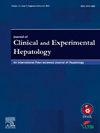晚期肝细胞癌患者立体定向体外放射治疗后存活率的预测因素和提名图(MAP-BNP)
IF 3.2
Q2 GASTROENTEROLOGY & HEPATOLOGY
Journal of Clinical and Experimental Hepatology
Pub Date : 2025-03-28
DOI:10.1016/j.jceh.2025.102555
引用次数: 0
摘要
背景:立体定向全身放射治疗(SBRT)是一种被广泛认可的治疗肝细胞癌(HCC)的方法,特别是在其晚期,其预后高度依赖于肿瘤负荷和基线肝功能。本研究旨在建立一个结合这些因素的预测模型和nomogram,以改善接受SBRT和全身治疗的晚期HCC患者的生存结果。方法回顾性分析2020年5月至2023年4月期间接受SBRT治疗的110例晚期HCC患者的记录。纳入标准包括年龄≥18岁、肝硬化和SBRT的适宜性。结果患者年龄中位数为63岁(28 ~ 84岁),主要病因为病毒性肝硬化(40.9%)和NASH(38.2%)。入院时,83.6%的患者有门静脉血栓形成,32.7%的患者有淋巴结转移,50%的患者有远处转移。肿瘤中位直径为9 cm, 73.6%的患者有多灶性病变。SBRT的中位剂量为35 Gy(范围25-45 Gy),分5次给予。三个月后,肿瘤标志物显著降低:甲胎蛋白水平从中位数309.75 ng/ml降至62 ng/ml (P = 0.015), PIVKA II从2230 mAU/ml降至345 mAU/ml (P = 0.001)。33%的患者完全缓解,45%的患者部分缓解。中位总生存期(OS)为14个月(95% CI 11.7-16.2), 6个月、12个月和24个月的OS率分别为90%、58%和34%。无进展生存期(PFS)为9个月(95% CI 6.4-11.5)。OS的重要预测因子包括多灶性肿瘤、门静脉血栓形成、淋巴结累及、血清胆红素、血清白蛋白和log PIVKA-II。开发的MAP-BNP nomogram C-index为0.853,优于child - turcot - pugh(0.62)和ALBI(0.64)评分。将患者分为低危组(<;200分)和高危组(>;200分),低危组OS明显延长(P <;0.001)。结合肿瘤负荷和肝功能的MAP-BNP nomogram预测晚期HCC患者SBRT和全身治疗的生存,优于传统的分期系统。本文章由计算机程序翻译,如有差异,请以英文原文为准。

Predictive Factors and Nomogram (MAP-BNP) for Post Stereotactic Body Radiotherapy Survival in Advanced Hepatocellular Carcinoma Patients
Background
Stereotactic body radiation therapy (SBRT) is a widely recognized approach for managing hepatocellular carcinoma (HCC), particularly in its advanced stages, with prognosis highly dependent on tumour burden and baseline liver function. This study aimed to develop a predictive model and nomogram that incorporates these factors to improve survival outcomes in advanced HCC patients treated with SBRT and systemic therapy.
Methods
We retrospectively reviewed records of 110 patients with advanced HCC treated with SBRT between May 2020 and April 2023. Inclusion criteria included age ≥18 years, cirrhosis, and suitability for SBRT.
Results
The median age was 63 years (range 28–84), with viral cirrhosis (40.9%) and NASH (38.2%) as the main aetiologies. At presentation, 83.6% of patients had portal vein thrombosis, 32.7% had nodal metastasis, and 50% had distant metastasis. The median tumour diameter was 9 cm, and 73.6% of patients had the multifocal disease.
A median SBRT dose of 35 Gy (range 25–45 Gy) in 5 fractions was administered. Significant reductions in tumour markers were noted at three months: AFP levels dropped from a median of 309.75 ng/ml to 62 ng/ml (P = 0.015), and PIVKA II from 2230 mAU/ml to 345 mAU/ml (P = 0.001). Complete and partial responses were seen in 33% and 45% of patients, respectively. The median overall survival (OS) was 14 months (95% CI 11.7–16.2), with OS rates of 90%, 58%, and 34% at 6, 12, and 24 months. Progression-free survival (PFS) was 9 months (95% CI 6.4–11.5). Significant predictors of OS included multifocal tumour, portal vein thrombosis, lymph node involvement, serum bilirubin, serum albumin, and log PIVKA-II. The developed MAP-BNP nomogram achieved a C-index of 0.853, outperforming the Child-Turcotte-Pugh (0.62) and ALBI (0.64) scores. Patients were classified into low-risk (<200 points) and high-risk (>200 points) groups, with the low-risk group showing a significantly longer OS (P < 0.001).
Conclusion
The MAP-BNP nomogram, integrating tumour burden and liver function, provides a more individualized approach for predicting survival in advanced HCC patients treated with SBRT and systemic therapy, outperforming traditional staging systems.
求助全文
通过发布文献求助,成功后即可免费获取论文全文。
去求助
来源期刊

Journal of Clinical and Experimental Hepatology
GASTROENTEROLOGY & HEPATOLOGY-
CiteScore
4.90
自引率
16.70%
发文量
537
审稿时长
64 days
 求助内容:
求助内容: 应助结果提醒方式:
应助结果提醒方式:


